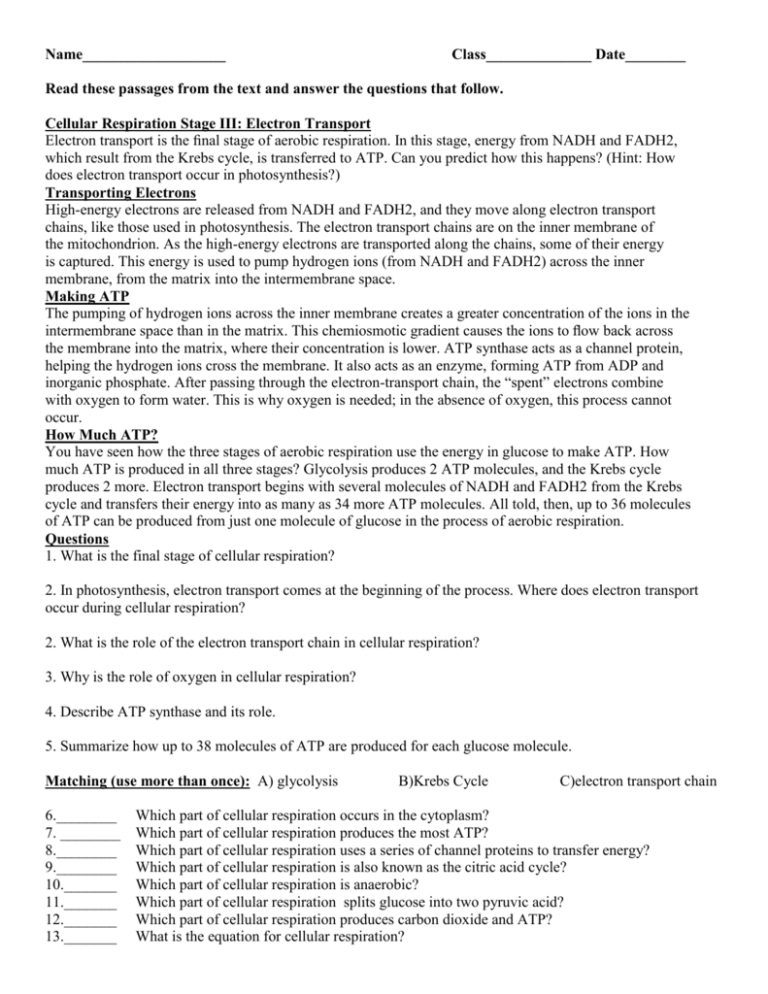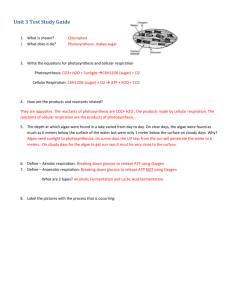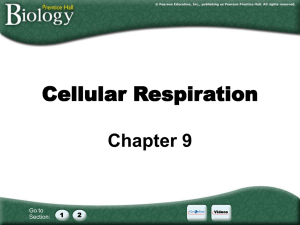Name___________________ Class______________
advertisement

Name___________________ Class______________ Date________ Read these passages from the text and answer the questions that follow. Cellular Respiration Stage III: Electron Transport Electron transport is the final stage of aerobic respiration. In this stage, energy from NADH and FADH2, which result from the Krebs cycle, is transferred to ATP. Can you predict how this happens? (Hint: How does electron transport occur in photosynthesis?) Transporting Electrons High-energy electrons are released from NADH and FADH2, and they move along electron transport chains, like those used in photosynthesis. The electron transport chains are on the inner membrane of the mitochondrion. As the high-energy electrons are transported along the chains, some of their energy is captured. This energy is used to pump hydrogen ions (from NADH and FADH2) across the inner membrane, from the matrix into the intermembrane space. Making ATP The pumping of hydrogen ions across the inner membrane creates a greater concentration of the ions in the intermembrane space than in the matrix. This chemiosmotic gradient causes the ions to flow back across the membrane into the matrix, where their concentration is lower. ATP synthase acts as a channel protein, helping the hydrogen ions cross the membrane. It also acts as an enzyme, forming ATP from ADP and inorganic phosphate. After passing through the electron-transport chain, the “spent” electrons combine with oxygen to form water. This is why oxygen is needed; in the absence of oxygen, this process cannot occur. How Much ATP? You have seen how the three stages of aerobic respiration use the energy in glucose to make ATP. How much ATP is produced in all three stages? Glycolysis produces 2 ATP molecules, and the Krebs cycle produces 2 more. Electron transport begins with several molecules of NADH and FADH2 from the Krebs cycle and transfers their energy into as many as 34 more ATP molecules. All told, then, up to 36 molecules of ATP can be produced from just one molecule of glucose in the process of aerobic respiration. Questions 1. What is the final stage of cellular respiration? 2. In photosynthesis, electron transport comes at the beginning of the process. Where does electron transport occur during cellular respiration? 2. What is the role of the electron transport chain in cellular respiration? 3. Why is the role of oxygen in cellular respiration? 4. Describe ATP synthase and its role. 5. Summarize how up to 38 molecules of ATP are produced for each glucose molecule. Matching (use more than once): A) glycolysis 6.________ 7. ________ 8.________ 9.________ 10._______ 11._______ 12._______ 13._______ B)Krebs Cycle C)electron transport chain Which part of cellular respiration occurs in the cytoplasm? Which part of cellular respiration produces the most ATP? Which part of cellular respiration uses a series of channel proteins to transfer energy? Which part of cellular respiration is also known as the citric acid cycle? Which part of cellular respiration is anaerobic? Which part of cellular respiration splits glucose into two pyruvic acid? Which part of cellular respiration produces carbon dioxide and ATP? What is the equation for cellular respiration? Definitions _____ 1. channel protein and enzyme that makes ATP _____ 2. also known as the Krebs cycle _____ 3. energy-carrying compound produced during the Krebs cycle _____ 4. end product of glycolysis _____ 5. cellular respiration in the absence of oxygen _____ 6. energy-carrying compound involved in stage I and stage II of cellular respiration _____ 7. cellular respiration in the presence of oxygen _____ 8. stage II of cellular respiration _____ 9. “folds” created by the mitochondria inner membrane _____ 10. glucose splitting _____ 11. involved in stage III of cellular respiration _____ 12. a greater concentration of hydrogen ions in the intermembrane space than in the mitochondrial matrix Terms a. aerobic respiration b. anaerobic respiration c. ATP synthase d. chemiosmotic gradient e. citric acid cycle f. cristae g. electron transport chain h. FADH2 i. glycolysis j. Krebs cycle k. NADH l. pyruvate Fill in the blank with the appropriate term. 1. The reactions of cellular respiration can be grouped into three stages: ____________, the ____________ cycle, and electron transport. 2. Cellular respiration in the absence of oxygen is called ____________ respiration. 3. The last two stages of cellular respiration occur in the ____________. 4. Most of the ATP is produced in stage ____________ of cellular respiration. 5. ____________ is the final electron acceptor at the end of the electron transport chain, when water is formed. 6. During glycolysis, enzymes split a molecule of glucose into two molecules of ____________. 7. ____________ releases the energy in glucose to make ATP. 8. During the Krebs cycle, energy is captured in molecules of ____________, ____________, and FADH2. 9. ____________ is the molecule that enters the Krebs cycle. 10. During glycolysis, ____________ molecules of ATP are used, and ____________ molecules of ATP are made. 11. ____________ is the enzyme that produces ATP during the final stage of cellular respiration. 12. In all three stages of aerobic respiration, up to ____________ molecules of ATP may be produced from a single molecule of glucose. Definitions _____ 1. an important way of making ATP without oxygen _____ 2. respiration in the absence of oxygen _____ 3. makes your muscles feel tired and sore after intense exercise _____ 4. recycles during fermentation _____ 5. perform cellular respiration in the presence of oxygen _____ 6. can use lactic acid fermentation for energy _____ 7. can use alcoholic fermentation for energy _____ 8. stage of cellular respiration that occurs with or without oxygen _____ 9. product of glycolysis _____ 10. energy in the cell _____ 11. fermentation in which pyruvic acid from glycolysis changes to lactic acid _____ 12. fermentation in which pyruvic acid changes to alcohol and carbon dioxide Terms a. aerobic organisms b. alcoholic fermentation c. anaerobic respiration d. ATP e. fermentation f. glycolysis g. lactic acid h. lactic acid fermentation i. muscle cells j. NAD+ k. pyruvic acid l. yeast








